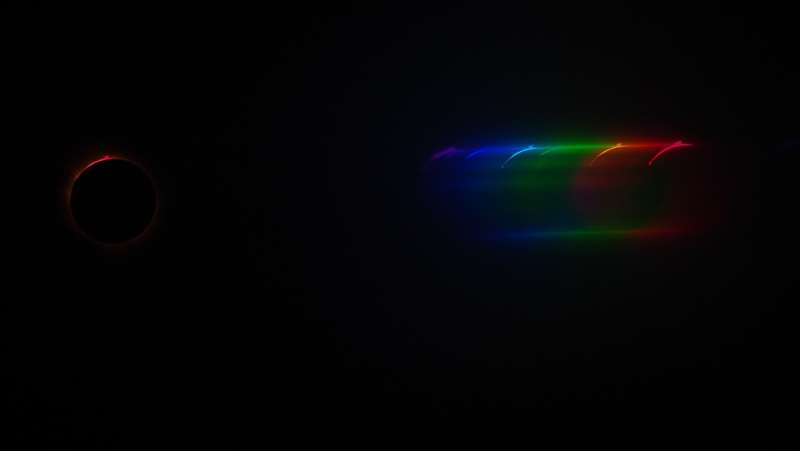Credit & Copyright: Len Fulham
Explanation:
In a flash, the
visible spectrum of the Sun changed from
absorption to emission on March 9
during the total solar eclipse.
That fleeting moment, at the beginning the total
eclipse phase, is captured by telephoto lens and
diffraction grating in this image from clearing skies over
Ternate, Indonesia.
At left, the overwhelming light from the Sun is just blocked
by the lunar disk.
The normally dominant absorption spectrum of the
solar photosphere is hidden.
What remains, spread by the
diffraction grating into
the spectrum of colors to the right of the eclipsed Sun,
are individual eclipse images.
The images appear at each wavelength of light
emitted by atoms along the thin visible arc of
the solar chromosphere and in an
enormous prominence extending beyond the Sun's upper limb.
The brightest images, or strongest
chromospheric emission lines,
are due to Hydrogen atoms that produce the red hydrogen
alpha emission at the far right and blue hydrogen beta
emission to the left.
In between, the bright yellow emission image is caused by atoms of
Helium,
an element only first discovered in the
flash spectrum of the Sun.
1999 2000 2001 2002 2003 2004 2005 2006 2007 2008 2009 2010 2011 2012 2013 2014 2015 2016 2017 2018 2019 2020 2021 2022 2023 2024 2025 |
Январь Февраль Март Апрель Май Июнь Июль Август Сентябрь Октябрь Ноябрь Декабрь |
NASA Web Site Statements, Warnings, and Disclaimers
NASA Official: Jay Norris. Specific rights apply.
A service of: LHEA at NASA / GSFC
& Michigan Tech. U.
|
Публикации с ключевыми словами:
spectrum - solar eclipse - Солнечное затмение - Спектр
Публикации со словами: spectrum - solar eclipse - Солнечное затмение - Спектр | |
См. также:
Все публикации на ту же тему >> | |
